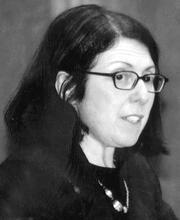Lucy Goldschmidt Moses
From young adulthood, Lucy Goldschmidt Moses was involved with volunteer work, first with children in settlement houses and later caring for the sick at Montefiore Hospital’s main wards and epilepsy clinic. After her marriage to financier Henry Moses in 1914, she joined her husband’s philanthropic projects, funding Montefiore Hospital, Columbia University’s medical school, and the Mount Sinai Medical Center, where she established a cardiac center. In 1942 the couple created the Henry and Lucy Moses Fund, supporting education, music, and the arts in New York. They also donated to medical care in Burma, South Korea, and Israel. After her husband’s death in 1961, Moses became director of the fund. She established the Henry L. Moses Research Institute at Montefiore Hospital and a study hall at Columbia University Law School in her husband’s memory, and supported Lincoln Center and other important cultural institutions throughout the city.
Lucy Moses combined philanthropy on a grand scale with volunteer social work over a long life. She left a legacy in the worlds of medicine, music, and the university, and devoted herself to improving recreational facilities in her home city, New York.
Early Life and Family
Lucy Goldschmidt was the daughter of Henry P. Goldschmidt and his wife, Georgette (née Woodleaf). Born and raised in New York City, she recalled skating and walking in Central Park as a child under the supervision of her governess. In later life she was honored for her contribution to restoring Central Park’s ornamental iron Bow Bridge. “They called me the ‘Florence Nightingale of the trees,’” she once commented, and she referred to Central Park, which her Fifth Avenue apartment overlooked, as “my backyard.” On December 1, 1914, she married Henry Moses, a lawyer and financier. They had one daughter, Nancy (Osserman).
Volunteer Work
From the time of her young adulthood Lucy volunteered regularly over a period of forty years, first in settlement house work. She would take the children of needy families to play in the park and would help prepare their meals at the community center of the Lenox Hill Settlement House. Beginning in the 1920s, she volunteered at Montefiore Hospital, in the wards and later in the epilepsy clinic. She liked the personal aspects of volunteer social work in the first half of the twentieth century.
Lucy joined her husband in his philanthropic interests, particularly in the field of medicine. Henry was the president of Montefiore Hospital for many years, and the couple’s philanthropy aided in its growth into a major American medical center. Lucy Moses established a cardiac center, named after her, at the Mount Sinai Medical Center. She also donated a major gift to Columbia University’s College of Physicians and Surgeons in honor of a doctor who had directed an epilepsy clinic at which she had volunteered.
Philanthropy
In 1942 the couple established the Henry and Lucy Moses Fund to distribute their philanthropy in the areas of education, music, and the arts. While primarily concerned with the wellbeing of New Yorkers, they also donated funds to medical care in countries as far afield as South Korea, Burma, and Israel. After her husband's death in 1961, Lucy assumed leadership of the Fund. She established the Henry L. Moses Research Institute at Montefiore Hospital as well as a study hall at Columbia Law School in her husband’s memory. She continued to be an important supporter of the opera and Lincoln Center, a leading New York cultural center, and funded programs in music and art education at a number of universities. She was also a major contributor to Jewish causes, supporting the Federation of Jewish Philanthropies and endowing a chair in modern Jewish history in her name at Yale University. The largest single gift of her one hundred and seventy million dollar estate went to the United Jewish Appeal—Federation of Jewish Philanthropies.
Death and Legacy
Lucy Moses’s life demonstrates how a woman born into, and married to, privilege could contribute not only to the society in which she lived but also to international causes. Regarding money, she commented, “I’m grateful I’ve been able to do things with it. I don’t think we’re worth anything unless we do for others.” Her combination of secular and Jewish commitments reflects the high level of acculturation and integration of prosperous American Jews in the larger society in the twentieth century.
Lucy Moses died in New York City on August 2, 1990. She was survived by her daughter and six grandchildren.
New York Times, June 12, 1983.
August 4, 1990.


![roisman.jpg - still image [media] roisman.jpg - still image [media]](http://cdn.jwa.org/sites/default/files/styles/medium/public/mediaobjects/roisman.jpg?itok=7iKIF0ev)




